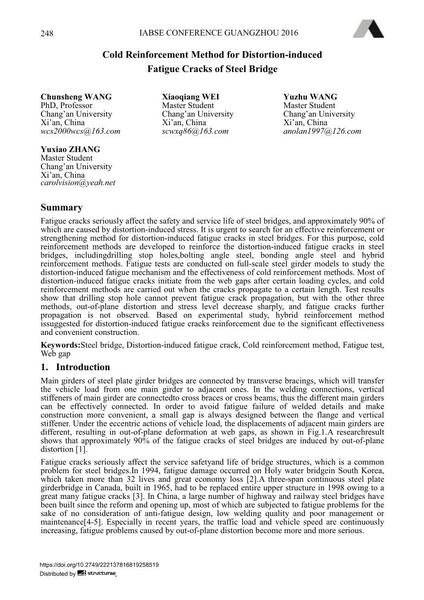Cold Reinforcement Method for Distortion-induced Fatigue Cracks of Steel Bridge

|
|
|||||||||||
Bibliographic Details
| Author(s): |
Chunsheng Wang
Yuxiao Zhang Xiaoqiang Wei Yuzhu Wang |
||||
|---|---|---|---|---|---|
| Medium: | conference paper | ||||
| Language(s): | English | ||||
| Conference: | IABSE Conference: Bridges and Structures Sustainability - Seeking Intelligent Solutions, Guangzhou, China, 8-11 May 2016 | ||||
| Published in: | IABSE Conference, Guangzhou, China, 8 – 11 May 2016 | ||||
|
|||||
| Page(s): | 248-255 | ||||
| Total no. of pages: | 8 | ||||
| Year: | 2016 | ||||
| DOI: | 10.2749/222137816819258519 | ||||
| Abstract: |
Fatigue cracks seriously affect the safety and service life of steel bridges, and approximately 90% of which are caused by distortion-induced stress. It is urgent to search for an effective reinforcement or strengthening method for distortion-induced fatigue cracks in steel bridges. For this purpose, cold reinforcement methods are developed to reinforce the distortion-induced fatigue cracks in steel bridges, includingdrilling stop holes,bolting angle steel, bonding angle steel and hybrid reinforcement methods. Fatigue tests are conducted on full-scale steel girder models to study the distortion-induced fatigue mechanism and the effectiveness of cold reinforcement methods. Most of distortion-induced fatigue cracks initiate from the web gaps after certain loading cycles, and cold reinforcement methods are carried out when the cracks propagate to a certain length. Test results show that drilling stop hole cannot prevent fatigue crack propagation, but with the other three methods, out-of-plane distortion and stress level decrease sharply, and fatigue cracks further propagation is not observed. Based on experimental study, hybrid reinforcement method issuggested for distortion-induced fatigue cracks reinforcement due to the significant effectiveness and convenient construction. |
||||
| Keywords: |
steel bridge Fatigue test Cold reinforcement method distortion-induced fatigue crack web gap
|
||||
